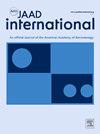Dermatoscopic markers of disease activity in vitiligo
IF 5.2
引用次数: 0
Abstract
Background
Determining vitiligo activity is essential for prognosis and treatment planning.
Objectives
To describe the dermoscopic findings and correlate them with the activity of the disease.
Methods
A single-center, descriptive, analytical study included 233 patients (330 lesions). Lesions were categorized as progressing, repigmenting, stable, or recent. Dermoscopic analysis was performed using a DermLite 4 dermatoscope, with statistical testing through Pearson’s chi-square.
Results
Progressing lesions were associated with trichrome pattern, reverse network, nacreous white globules, starburst, comet-tail pattern, micro-Koebner phenomenon, residual peripilar pigmentation with leukotrichia, perilesional polka dots, perifollicular depigmentation, and reverse network (P < .01). Stability was indicated by sharp borders (P < .01). Repigmenting lesions exhibited perifollicular or border hyperpigmentation, erythema, and telangiectasias (P < .01). Early vitiligo was suggested by hypopigmented lesions with attenuated network or perifollicular depigmentation (P < .01). Newly identified markers included distally pigmented bicolored hair for recent lesions and proximally pigmented bicolored hair for repigmentation.
Limitations
Most patients had prior treatment, potentially influencing dermoscopic patterns.
Conclusion
This study, based on a large sample size, identifies specific dermoscopic markers for vitiligo activity and introduces novel findings like bicolored hairs. These insights can refine clinical assessment and serve as a foundation for future research.
白癜风疾病活动的皮肤镜标记物
背景:确定白癜风活动对预后和治疗计划至关重要。目的描述皮肤镜下的表现,并将其与疾病的活动性联系起来。方法采用单中心、描述性、分析性研究,纳入233例患者(330个病变)。病变分为进展型、重色素沉着型、稳定型和近期型。皮肤镜分析采用DermLite 4型皮肤镜,Pearson卡方统计学检验。结果进展性病变与三色型、反网状、珍珠状白球、星暴型、彗星尾型、微koebner现象、残留毛囊周围色素沉着伴白斑、皮损周围圆点、毛囊周围色素沉着、反网状相关(P < 0.01)。清晰的边界表明其稳定性(P < .01)。再着色病变表现为滤泡周围或边缘色素沉着、红斑和毛细血管扩张(P < 0.01)。早期白癜风提示色素减退病变伴网状或毛囊周围色素减退(P < 0.01)。新发现的标记包括最近病变的远端着色双色头发和重新着色的近端着色双色头发。局限性:大多数患者先前接受过治疗,可能影响皮肤镜检查模式。结论本研究基于大样本量,确定了白癜风活动的特异性皮肤镜标记,并引入了双色头发等新发现。这些见解可以完善临床评估,并为未来的研究奠定基础。
本文章由计算机程序翻译,如有差异,请以英文原文为准。
求助全文
约1分钟内获得全文
求助全文

 求助内容:
求助内容: 应助结果提醒方式:
应助结果提醒方式:


